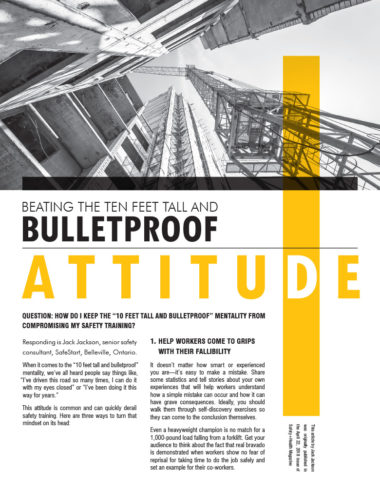This article by Jack Jackson was originally published in the April 22, 2018 issue of Safety+Health Magazine
Question: How do i keep the “10 feet tall and bulletproof” mentality from compromising my safety training?
Responding is Jack Jackson, senior safety consultant, SafeStart, Belleville, Ontario.
When it comes to the “10 feet tall and bulletproof” mentality, we’ve all heard people say things like, “I’ve driven this road so many times, I can do it with my eyes closed” or “I’ve been doing it this way for years.”
This attitude is common and can quickly derail safety training. Here are three ways to turn that mindset on its head:
1. Help workers come to grips with their fallibility
It doesn’t matter how smart or experienced you are—it’s easy to make a mistake. Share some statistics and tell stories about your own experiences that will help workers understand how a simple mistake can occur and how it can have grave consequences. Ideally, you should walk them through self-discovery exercises so they can come to the conclusion themselves.
Even a heavyweight champion is no match for a 1,000-pound load falling from a forklift. Get your audience to think about the fact that real bravado is demonstrated when workers show no fear of reprisal for taking time to do the job safely and set an example for their co-workers.
2. Tap into natural motivation
 There are two major types of motivation. The first, called intrinsic motivation, is when people are motivated by their own interest and internal desires. It’s a pretty safe assumption that almost no one is intrinsically motivated to pay attention to safety training.
There are two major types of motivation. The first, called intrinsic motivation, is when people are motivated by their own interest and internal desires. It’s a pretty safe assumption that almost no one is intrinsically motivated to pay attention to safety training.
The second type is extrinsic motivation, which is when people are motivated by other goals. If someone feels like they’re 10 feet tall and bulletproof, there’s no point in telling them that safety training is going to help them avoid injury because they believe that they’re already safe enough. This mentality is reinforced by the absence of incident; because nothing has happened to them personally, they feel like it never will.
Fortunately, you don’t need to appeal to their personal safety for extrinsic motivation. Instead, appeal to their family’s safety. There are several ways you can leverage people’s natural desire to keep their family safe. Training can be framed as an opportunity to pass on skills from the workplace to home. So, when you’re reviewing safety requirements, for example, discuss how people can teach a similar safety sensibility to their family, and how their own actions will set an example for their children.
Take it a step further and provide resources that are geared to off-the-job safety. Make it as easy as possible to provide safety lessons to family, because there’s no such thing as “safe enough” when it comes to loved ones.
3. Get everyone in the same room
It’s difficult to have a holier-than-thou attitude toward safety when everyone is in the same room.
If your plant manager, shift supervisors and other leaders are sitting in the first row of safety training, it will very clearly signal that the training is mandatory—no ifs, ands or buts. It also makes workers see the training as important and inclusive.
We all make mistakes, and we all have a little bit of the “10 feet tall and bulletproof” mindset in us. However, if we lead the change by displaying good safety habits and practices, a positive transformation will take place naturally over time.
William “Jack” Jackson is a senior safety consultant at SafeStart, a global organization that provides safety training to reduce the impact of human error. He holds a Bachelor of Science in Mechanical Technology and uses his manufacturing, military and sports experience to provide engaging training session that teach participants that “safety is always first.”

Get the PDF version
You can download a printable PDF of the article using the button below.

